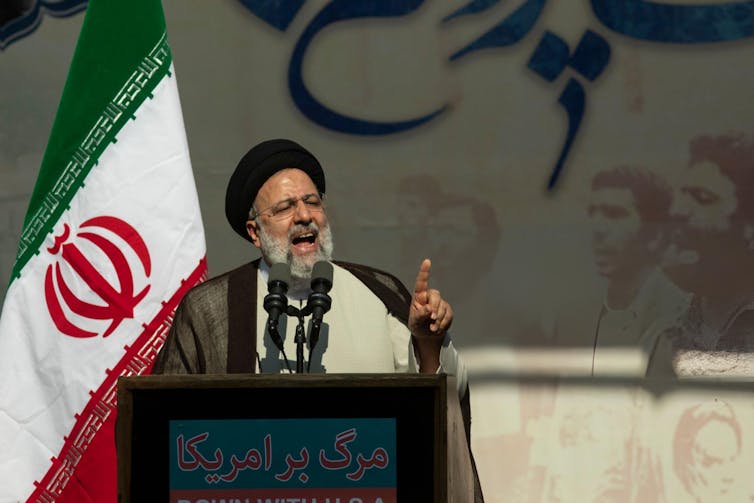A helicopter carrying Iranian president Ebrahim Raisi, the country’s foreign minister and other officials crashed in the mountainous north-west reaches of Iran on Sunday May 19, sparking a rescue operation in thick fog and driving rain. On Monday, search and rescue teams reached the crash site and “found no signs of the helicopter’s occupants being alive”.
The death of Raisi and his foreign minister will shake up Iranian politics. Who was Raisi? What happens now? And what could his death mean for stability in the country and beyond? We spoke with Scott Lucas, a Middle East scholar at University College Dublin, who has been writing about tensions in the Middle East for many years.
Who was Ebrahim Raisi?
Raisi was a dedicated servant of Iran’s former supreme leader (the country’s highest authority), Ayatollah Ruhollah Khomeini. Rising through the judicial system in the 1980s, Raisi came to prominence as a member of the “death committee” imposing capital punishment on thousands of detainees in 1988 at the end of the Iran’s war with Iraq.
The exact number of those who were sentenced to death is not known. But human rights groups have estimated conservatively that about 5,000 men and women were executed in what has been described as a crime against humanity. Raisi denied his role in the death sentences, but also said they were justified because of a religious ruling by Khomeini.
He has also served as deputy chief of justice, attorney general and then a chief of justice. He crafted an image as a leader that was tough on corruption while also working to purge opponents of the regime. In 2016, he was also appointed by the supreme leader to oversee the Astan Quds Razavi religious foundation, which controls tens of billions of US dollars.
In June 2021, Raisi was installed as president in Iran’s elections, handing the elected leadership back to the hardliners. The result came as no great surprise. Raisi was seen as the candidate of the current supreme leader, Ayatollah Ali Khamenei, and the clerical establishment moved to promote his election and impede challengers.
How big of a blow is losing Raisi for the regime?
Raisi was considered loyal to Khamenei and often took on the role of a scapegoat to help the supreme leader avoid criticism. It is because of this loyalty that, despite being seen as unexceptional and even weak by many in Iran’s political system, Raisi had been mentioned as a possible successor to the supreme leader.
But, in itself, the loss of Raisi has little effect on the Iranian system. He was largely a placeholder representing the wishes of the supreme leader, the Revolutionary Guard Corps and hardliners.
The bigger challenge is replacing Raisi with a minimum of in-fighting in the Iranian regime, maintaining the ostracism of reformists and centrists, and suppressing any protests.

Following the crash, Khamenei reassured Iranians there would be “no disruption to the work of the country”. How true is this claim?
The supreme leader’s statement is best understood as a call to Iranians to avoid “disruption”, given the series of nationwide protests that erupted after the contested result of Iran’s 2009 presidential election.
The incumbent president at the time, Mahmoud Ahmadinejad, was declared the outright winner against many people’s expectations. Widespread unrest followed and thousands of people were arbitrarily arrested, and dozens were killed on the streets or died in detention.
Khamenei’s rhetoric is also an “all is well” proclamation defying the serious economic problems and regional tensions that Iran faces. Iran’s economy has been in a parlous state for years, through a combination of mismanagement and sanctions. The currency is at a historic low, having lost 93% of value since 2018. Inflation remains above 40% officially and far higher unofficially. And unemployment is high, especially among the younger generation.
The regime continues to suppress protests through detentions and intimidation. But demands for reforms are still widespread. They have been galvanised by the regime’s crackdown over compulsory hijab. Iran’s authorities have tried to quash centrists as well as reformists, but face a backlash from public criticism, including that of former president, Hassan Rouhani.
Who will replace Raisi?
If a president dies in office, Iran’s constitution says that the first vice president takes over for a period of 50 days, with the approval of the supreme leader. A new presidential election is then held at the end of the interim period. Khamenei has confirmed that the first vice president, Mohammad Mokhber, will serve as the country’s acting president until elections are held.
The process will be an accelerated version of the standard procedure, with a 12-member guardian council vetting all candidates and disqualifying those deemed not acceptable. That should ensure a contest between a hardliner and a conservative, blocking any high-profile centrist or reformist.
Different factions within government will be manoeuvring for the supreme leader’s favour. Raisi’s occupancy has signalled the ascendancy of hardliners throughout the regime, pushing aside conservatives. However, there is no clear hardline favourite at this point.
Meanwhile, parliament speaker and former presidential candidate, Mohammad Qalibaf, may be the most likely conservative. He has been at the forefront of Iranian politics for 25 years. But he has also failed in two presidential campaigns, and is unacceptable to many hardliners.
What could Raisi’s death mean for stability in the Middle East and beyond?
The regime will want to avoid any further turmoil in the regime while it rearranges the desk chairs of power. This includes the replacement of foreign minister, Hossein Amir-Abdollahian, who had played an important role in trying to present Tehran’s case to the world and finding ways to ease the impact of western sanctions.
The open question is whether Israel, embroiled in its war in Gaza and serious domestic tension around Prime Minister Benjamin Netanyahu, will return to attacks on Iranian interests, such as its targeted assassinations of Tehran’s commanders in Syria and Hezbollah officials in Lebanon.

